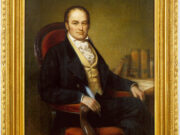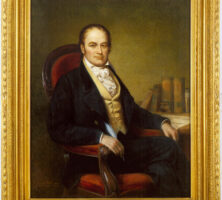No other Georgian of his time achieved as much political prominence in the early national period as did William Harris Crawford.
A two-time U.S. presidential nominee and the only Georgian to run for the presidency prior to the twentieth century, Crawford campaigned in both 1816 and 1824. Although best known nationally for his 1824 bid for the presidency, the most controversial presidential election in U.S. history up to that point, Crawford served the state and nation in a variety of ways, including terms as a U.S. senator, cabinet member under two presidents, and foreign diplomat. His younger cousin, George W. Crawford, served as Georgia’s governor in the 1840s.
Education and Early Career
Crawford was born on February 24, 1772, in Amherst County (later Nelson County), Virginia, to Fanny Harris and Joel Crawford. The family moved to the Edgefield District of South Carolina in 1779 and then to Richmond County (later Columbia County), Georgia, in 1783. After several years of teaching and farming, Crawford enrolled at Moses Waddel’s Carmel Academy in Appling, and later at Richmond Academy in Augusta. He studied law privately, was admitted to the bar, and began practice in Lexington in 1799.

In 1804 he married a former pupil, Susanna Gerardin, soon after purchasing his Woodlawn estate in Lexington. They had nine children; their son Nathaniel would become a mathematics professor at Oglethorpe University in Atlanta and the president of Mercer University in Macon. William Crawford aspired to live the life of a country gentleman, but he would not get the chance to do so until the end of his career. In the meantime he gradually added to his landholdings at Woodlawn and became the overseer of a good-sized plantation. By 1834 he owned 1,300 acres and enslaved forty-five people.
Crawford’s brawny physique and straight-talking, non-rhetorical character earned him both friends and enemies in Georgia. He opposed the Yazoo Act of 1795, which transferred 35 million acres of the state’s western frontier (in present-day Alabama and Mississippi) to speculators and became known as the Yazoo Land Fraud. The controversy eventually led to the famous Fletcher v. Peck (1810) decision.
State Political Career
Crawford’s political career got under way in 1799, when he was appointed to write a digest of Georgia laws, and the resulting work, Digest of the Laws of the State of Georgia, written with Horatio Marbury, was published in 1801.
In 1803 Crawford was elected to represent Oglethorpe County in the state House of Representatives. He quickly allied himself with U.S. senator James Jackson. The leading opponent of gross land speculation, Jackson was a hero of the Revolutionary War (1775-83) and former governor of Georgia. His allies, known over time as the Jackson, the Crawford, and the Troup Party, were a powerful faction of the Jefferson party. This faction consisted of aristocratic plantation owners and residents of the more affluent, established areas of Georgia. Their powerful enemies were the Clarkites, led initially by Elijah Clarke and later by his son John Clark, whose supporters included small farmers and frontier settlers.
The factional rivalry descended into a violent feud in 1802, when Crawford killed Peter Van Alen, one of Clark’s allies. Four years later John Clark wounded Crawford in a duel. Unsatisfied with the result, Clark challenged him again, but Crawford refused. In a fit of anger over Crawford’s unwillingness to meet, Clark cornered a Crawford ally, Judge Charles Tait, in the streets of Milledgeville and severely whipped him with a riding crop. Clark was fined $2,000 for the incident, which was a reflection of the deep-seated division between the two political factions.
National Political Career
Upon the death of U.S. senator Abraham Baldwin in 1807, the state legislature chose Crawford to replace him. True to his character, Crawford refused to be bound by partisan loyalties in Washington D.C., which helped win him reelection in 1811. That same year, Crawford supported the rechartering of the Bank of the United States; he understood the bank to be a constructive institution because it stabilized the economy, acted as a fiscal agent for the government, and restrained sometimes irresponsible state banks.
Crawford also, however, after rising to clarify provisions in its hasty passage, supported U.S. president James Madison’s embargo measures against Great Britain and France. As the possibility of war with Britain loomed, Crawford was initially cautious with his position, asserting the superiority of the British military, yet he felt fundamentally that military force was needed. He cautioned about Spanish action in Florida, Britain’s ally. In 1813, after the outbreak of the War of 1812 (1812-15), President Madison offered Crawford the position of secretary of war, but he, along with several others, declined due to the looming likelihood of a new war with Britain. Yet he did accept Madison’s appointment as minister to France that same year.
Before returning from France in 1815, Crawford learned of his appointment as secretary of war from the British newspapers. Although he had expected to retire from public life, he accepted the unexpected appointment, serving for a little more than a year. His short tenure was marked with some success in making the War Department a more efficient and prepared peace-time institution. Crawford reluctantly moved on to become secretary of the treasury in late 1816, yet it was there that he built his bureaucratic legacy. That same year Crawford was also a presidential nominee, but he garnered only fifty-four votes to James Monroe’s sixty-five votes from the Republican congressional caucus, which represented the remnants of Jeffersonian ideology. Monroe won the general election easily and asked Crawford to continue heading the Treasury Department. With the department in shambles due to the poor financing of the War of 1812, Crawford helped to organize the treasury more efficiently, with help from an act of Congress in 1817 that placed both civil and military accounts under the Treasury Department’s control. He also oversaw several major internal improvements, including the creation of a fort system along the Eastern Seaboard and construction of the Cumberland Road from Virginia to the Midwest.
The early 1820s saw the end of the first party system, which had grown out of the rivalry between Thomas Jefferson, whose supporters made up the Democratic Republican (or Republican) Party, and Alexander Hamilton, who led the Federalist Party. The void created by the demise of the Federalists caused the remaining Republican Party to splinter during the presidential contest of 1824, with no incumbent running for reelection and four major candidates in contention for the White House.
Crawford found himself running against John Quincy Adams of Massachusetts, Andrew Jackson of Tennessee, and Henry Clay of Kentucky. (John C. Calhoun was in the race briefly, before withdrawing to run for the vice presidency instead.) At that point, Crawford was as prominent as any of his rivals, but the effects of a stroke in 1823 put him at a disadvantage the following year, despite a nearly full recovery. He ultimately finished third, behind Jackson and Adams. Despite a substantial majority of popular votes, Jackson received less than a majority of the electoral votes, which threw the vote into the House of Representatives. In what Jackson’s supporters later labeled the “Corrupt Bargain,” Clay gave his support to Adams in exchange for appointment as his secretary of state.
Crawford refused reappointment as secretary of the treasury under President Adams and returned home for a long-awaited retirement. In 1827 he was appointed judge of the Northern Circuit of the Superior Court of Georgia.
He died near Elberton on September 15, 1834, while on the judicial circuit. Crawford County, the town of Crawford in Oglethorpe County, and the town of Crawfordville in Taliaferro County are all named for him.






